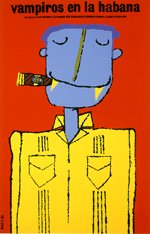Cuban Posters 1960 - 2000
dal 15/9/2006 al 16/12/2006
Segnalato da
15/9/2006
Cuban Posters 1960 - 2000
Centre de la Gravure et de l'Image Imprimee, La Louviere
Jose' Lambert Collection

Jose' Lambert Collection
Curator Catherine de Braekeleer
The most memorable images of the island’s history and its regime appear on the country’s walls. Given the government’s determination to use posters as a tool in education and political propaganda, the street became the preferred location for communication. Contrary to what happened in other communist states, artists were granted the greatest artistic freedom of expression. Consequently we have the privilege of seeing images that are both aesthetically very emotional and truly convincing, in the cultural as well as in the political field. ICAIC (Cuban Institute for Art and the Cinematographic Industry, 1960) and OSPAAL (Organisation for the Solidarity between Asian, African and Latin American Peoples, 1966) produced most of the Cuban posters. Those on show are rare or unique examples, which adds to the historical and aesthetic value of the exhibition. They bear witness to the enormous cultural heritage of the island. Amongst the artists on show are Azcuy, Bachs, Morante, Niko, Reboiro, Rostgaard… The 180 posters exhibited here all come from Jose' Lambert’s collection, which currently numbers more than 700 pieces. These are original silkscreen prints, whereas most current posters are reprints published to keep the legendary image of Cuban cinema alive.
The revolutionary posters
In 1959, the actors of the Cuban revolution wanted to reach out to the population: the masses were to be mobilised and slogans carried in the street. Oil paintings - aside from their bourgeois character - could not be quickly reproduced. Posters on the other hand, far from all elitist culture, appeared to be better adapted as a means of expression. They allowed for wide distribution on the walls of the city and their design evolved freely according to the changing political messages. Fidel Castro had a strong and positive interest in the political and cultural posters that served to promote the revolution. In 1960, El Comandante declared the right of intellectuals, artists and scientists to fight for a better world through their work. All styles could be used, all themes could be treated ...as long as the Revolution was not criticized.
Politics and movies
At first the political poster drew its inspiration from Soviet socialist realism, then later from the international avant-garde - with expressionist drawings, a surrealist tendency, graphic symbols, collages, wood engravings. The language remained stereotyped and conventional. Then it found a new language, based on synthesis. But the graphic simplicity was compensated by a remarkable explosion of colours, with a strong relation between text end picture. The poster used the iconic reference, the graphic idea, expressive colour and the power of the slogan.
As early as 1959, the cinema industry was nationalised and experienced a golden age. Each year it produced more than de 300 feature films and a great number of documentaries. Movies became an instrument of literacy and education of the masses. Graphic artists believed they could both give pleasure and educate people to art. Design was figurative, the techniques varied - assemblies, collages, multiplication of images. It was a true explosion of styles, of forms, of colours. Metaphors, visual jokes and symbols gave the spectator new subjects to think about. American pop art and European expressionism were integrated.
Image: BACHS Eduardo Munoz Vampiros en La Habana, 1985
Publication
Cuba s’affiche. 80 page booklet in colour. Introduction by Catherine de Braekeleer. Texts by Jose' Lambert, Ve'ronique Blondel and Julie van der Vrecken. Price : 13,00 € during the exhibition, 15,00 € after December 17 2006
Loan
This exhibition is produced by the Centre de la Gravure and is available for loan.
For further information please contact our press relations officer.
Events:
# Cuban night on November 10th at 6pm - guided tour of the exhibition followed by a Cuban cocktail and the movie << Habana Blues >> by Benito Zambrano.
# Singing tour with comments by <
Centre de la Gravure et de l'Image Imprimee
Rue des Amours 10 - La Louviere
Hours: From Tuesday to Sunday: 11am-6pm. On Monday only by appointment for groupsimum 20 persons.)



